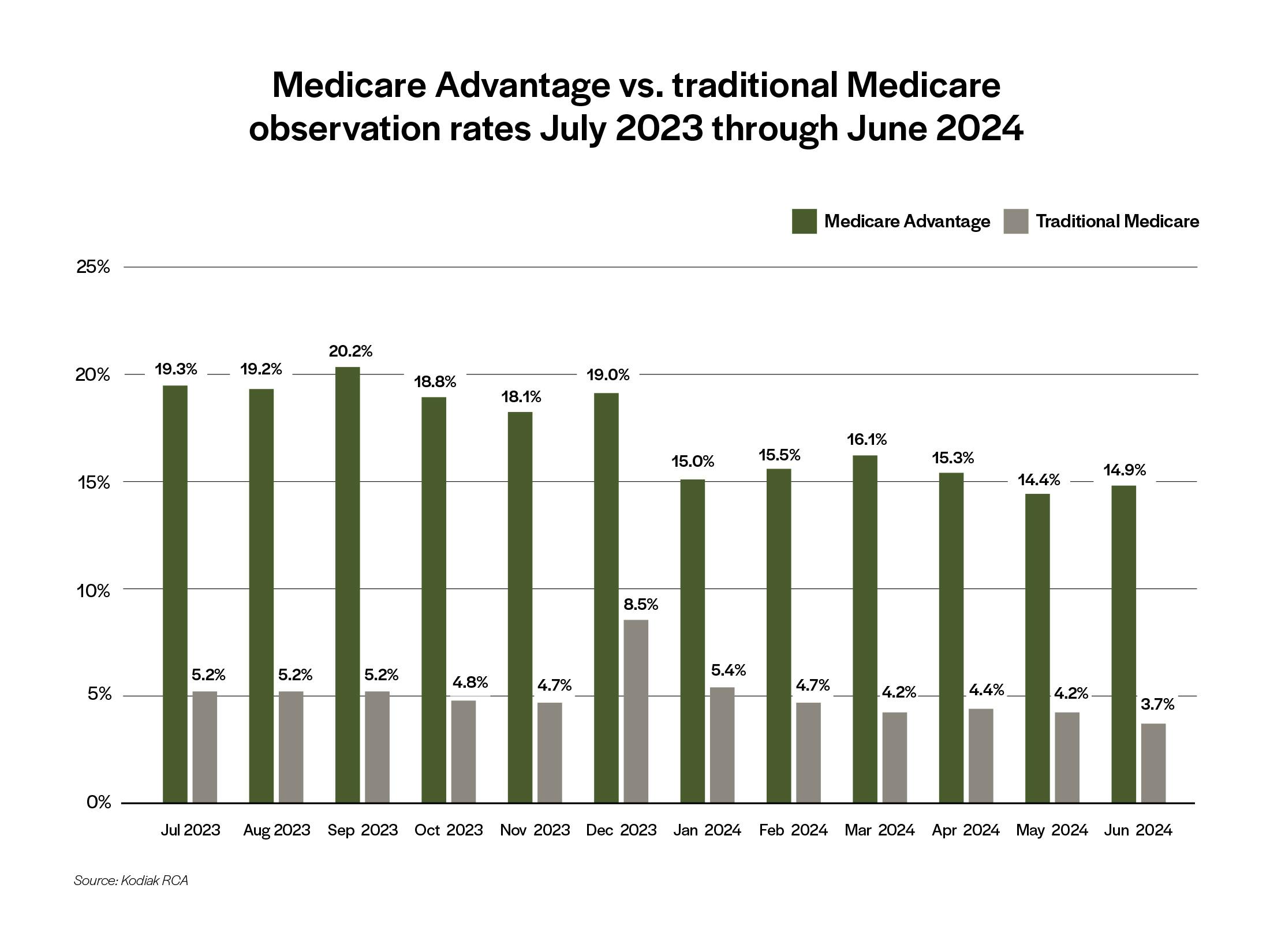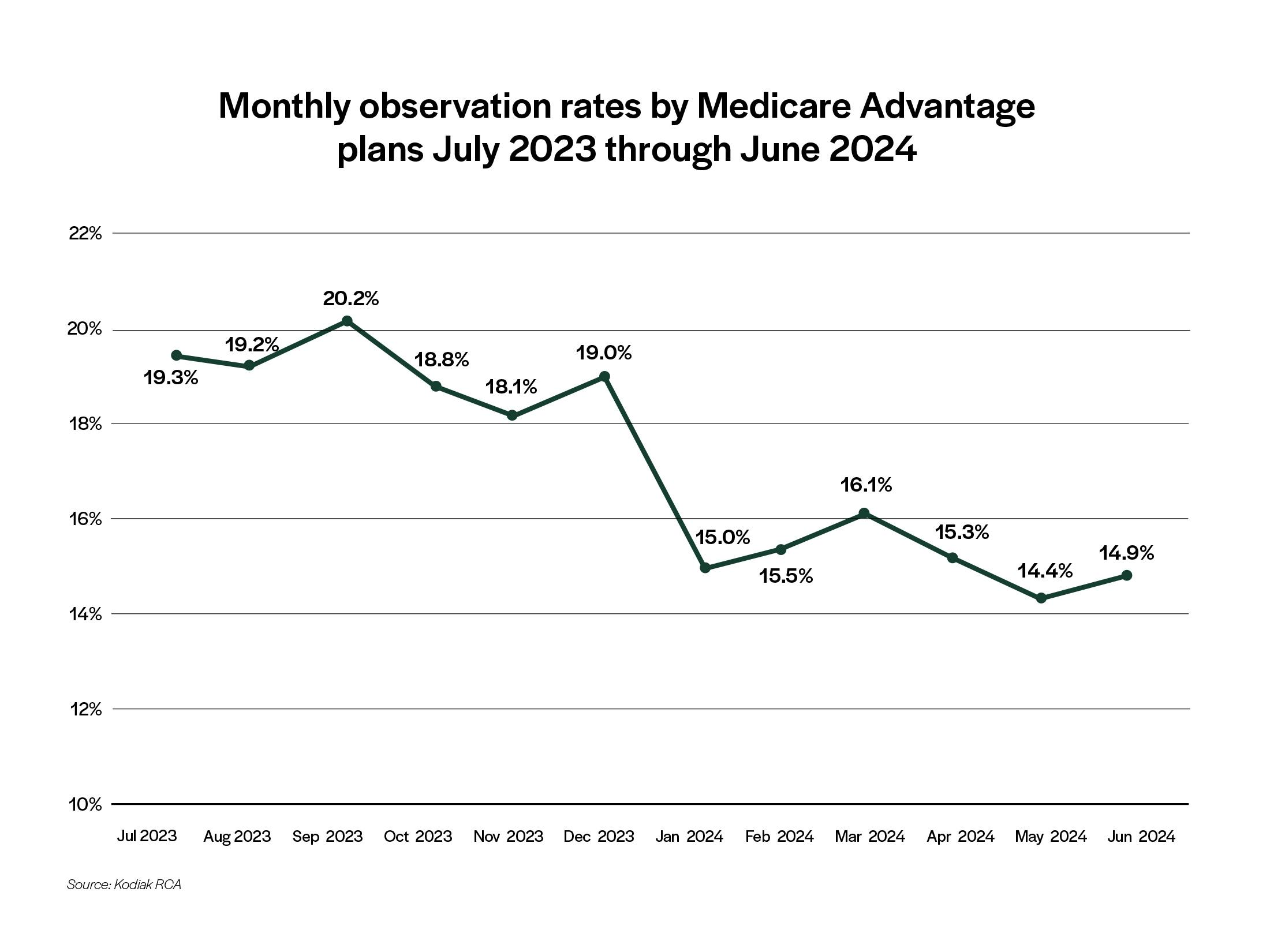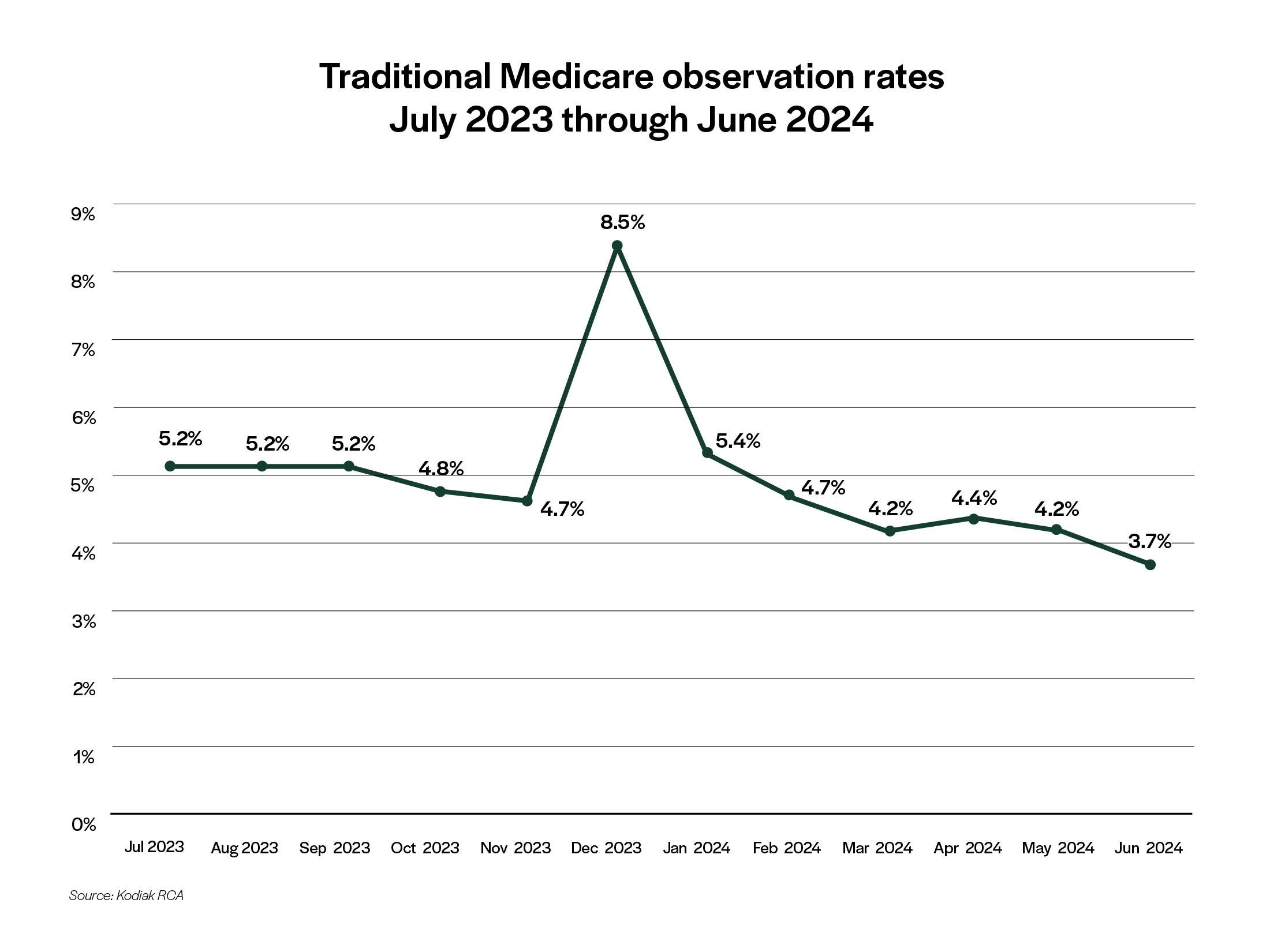November 2024 Revenue Cycle KPI Benchmarking Quarterly Report
Exclusive data from Kodiak reveals wide variations in patient observation rates, suggesting commercial payors are playing fast and loose with Medicare’s Two-Midnight Rule requirements for their Medicare Advantage plans
Nov 12, 2024

Some people are rule followers. Others are rule breakers. You know which one you are.
But providers don’t know which one their payors are despite providers having their suspicions.
A new analysis by Kodiak Solutions of hospital inpatient and outpatient claims data strongly suggests that health plans are rule breakers when it comes to the Two-Midnight Rule set by the Centers for Medicare and Medicaid Services to determine how to cover and pay hospitals for care provided to Medicare beneficiaries.
The analysis reveals wide variations in patient observation rates among three health plan types and wide variations in patient observations rates within a health plan type over time. Assuming little variation in the severity of illness of beneficiaries over the same time period and consistent clinical documentation and coding accuracy by providers, something is behind the variations in observation rates. That something likely is health plans’ claims paying behaviors and their response to recent rule changes CMS has put in place for Medicare Advantage plans.
Two-Midnight rule primer
CMS implemented the Two-Midnight Rule in 2014 to help hospitals, physicians, and Medicare auditors determine whether Medicare should pay hospital stays for traditional, fee-for-service Medicare beneficiaries as inpatient services or outpatient observation services.
Prior to implementation of the rule, hospitals and Medicare auditors used different and highly variable medical review approaches. Generally speaking, the Two-Midnight policy considers a hospital stay inpatient when the patient meets certain clinical criteria and when the attending/admitting physician believes that the patient will stay in the hospital for a period of time that will span at least two midnights.
This approach to determining coverage and payment of inpatient care allows the clinician’s judgment to direct the care while also providing a general rule about length of time in a hospital bed. The rule is flexible enough that inpatient care can be less than two nights in the hospital, while at the same time it allows observation to go beyond a two-day stay. It all depends on the patient’s condition.
The rule only applied to beneficiaries covered by traditional Medicare fee-for-service. As more Medicare beneficiaries enrolled in Medicare Advantage plans, hospitals began to experience high denial rates for care that traditional Medicare would cover and pay for as inpatient services.
CMS subsequently took steps to ensure that beneficiaries enrolled in MA plans receive the same covered services as beneficiaries in traditional fee-for-service. In 2023, CMS finalized a rule clarifying requirements that MA plans have to offer the same covered services. CMS highlighted the Two-Midnight Rule as an area where MA beneficiaries should receive comparable and equitable coverage and care.
Commercial payors use their own criteria to make determinations on inpatient versus outpatient status for their members enrolled in their own commercial health plans. But starting January 2024, CMS requires MA plans operated by commercial payors to use traditional Medicare’s Two-Midnight Rule for their MA plan members. Here is the link to CMS fact sheet on the Two-Midnight rule for a more detailed explanation.
Kodiak analysis of claims data
Hospitals suspect that MA plans are ignoring the Two-Midnight rule criteria for their MA plan members. Instead, they believe MA plans are continuing to use their own narrow, less regulated criteria used for their commercial plan members and arbitrarily downgrading inpatient claims to observation status for their Medicare beneficiaries enrolled in MA plans.
Kodiak decided to run the numbers to find out what’s going on. The claims data used in the analysis comes from Kodiak Revenue Cycle Analytics. More than 1,900 hospitals and 250,000 physicians across the country, which collectively represent $1.4 trillion in annual gross revenue, use RCA and the Kodiak platform to manage their net revenue and monitor their revenue cycle performance.
The analysis compares observation rates prior to and following the January 2024 implementation of the Two-Midnight Rule for MA plans for three health plan categories: commercial/managed care health plans; managed Medicare, or MA, health plans; and traditional Medicare. To add clarity and most closely identify the patient populations where the Two-Midnight Rule would apply in each category, the analysis focused on inpatient and observations stays with a length of stay of two or more days.
The key performance indicator highlighted within the analysis is the observation rate, which is a measure of the volume of cases that were assigned an outpatient observation level of care as a proportion of all bedded stays, which include both inpatient and observation levels of care.
Generally, patients receive the same level of care when they have stayed for two or more nights in a hospital bed – the key difference is how much health plans pay hospital for that care. The analysis revealed four trends

1. The observation rate for MA plans is significantly higher than for traditional Medicare

Perhaps the most important finding of the Kodiak analysis—and one that supports the suspicions of hospitals and health systems—is the fact that observation rates for MA plan members continue to be significantly higher than for traditional Medicare beneficiaries. That’s despite the notable decline in MA plan observation rates as shown in Chart 2. In fact, the MA observation rate in July 2023 was slightly less than four times the traditional Medicare observation rate. By June, the MA observation rate was slightly more than four times the traditional Medicare observation rate. These data show that while MA plans seem to be following the Two-Midnight Rule in some cases, there is still a big gap and MA beneficiaries are not qualifying for the same level of inpatient coverage as their traditional Medicare counterparts.
2. The observation rate for MA plans is falling

The decline in the observation rate for MA plan members reflects the effect of CMS’ requirement that MA plans start following the same Two-Midnight Rule clinical criteria as traditional Medicare beginning in January of this year. Note the big decline from 19.0% in December 2023 to 15.0% in January 2024. This suggests commercial payors are increasingly adhering to the traditional Medicare guidelines for their MA members, resulting in fewer denials for inpatient stays.
3. The observation rate for traditional Medicare is falling

Perhaps the most unexpected finding of the Kodiak analysis is that the observation rate for beneficiaries with traditional Medicare coverage also is falling this year. The 3.7% rate posted in June this year is the lowest in at least the previous 18 months. Possible explanations include a more standardized approach by providers nationwide to utilize the Two Midnight Rule when assigning a patient’s level of care, improved clinical documentation and more accurate coding by providers, a higher percentage of Medicare patients who require inpatient care versus outpatient care as more care moves to ambulatory or virtual settings or less scrutiny of inpatient claims for traditional Medicare beneficiaries.
4. The observation rate for commercial/managed care health plans is rising again after a modest dip

The rise in the observation rate for commercial/managed care health plans to 18.5% in June from 15.0% in January represents a 23.3% increase in just six months. The rise highlights a shift in payor claims-paying behavior with commercially insured managed-care patients and providers are again facing more aggressive inpatient denial tactics. This rise also suggests that payors are focusing more on commercial lines as a way to manage inpatient denial rates, possibly due to tightening regulations in the traditional and managed Medicare space. It’s important to make clear that many of the largest commercial payors also make up the majority of the managed Medicare marketplace.
The chart below illustrates the growing gap between Medicare Advantage and traditional Medicare observation rates with the spillover effect on commercial health plan observation rates.

The growing disparity between health plans suggests that even though commercial payors are reducing Two-Midnight Rule denials with MA members, there’s still a much greater likelihood that MA members and their providers will face more inpatient claims denials for hospital stays compared with beneficiaries with traditional Medicare coverage.
What hospital advocacy groups are saying
This finding supports the advocacy positions of the American Hospital Association and the Federation of American Hospitals.
In a recent report on hospitals’ rising administrative costs, the AHA cited the rising time and expense of appealing and overturning inappropriate claim denials by MA plans as a leading cause.
Meanwhile, the FAH says MA plans are failing to fully comply with traditional Medicare FFS coverage policies, including the Two-Midnight rule. Such claims-paying behavior by MA plans “will continue to put patients at risk for inpatient care denials and downgrades to days in the hospital with payment levels only for observation,” the FAH says.
The FAH wants CMS to enforce the Two-Midnight requirements on MA plans.
What hospitals and health systems can do
Whether commercial insurers will comply with Two-Midnight requirements for its MA plan members, or whether CMS steps up its enforcement of MA plans, is unknown.
What is known is what hospitals and health systems can do about it.
Regarding the rise in the observation rate for commercial/managed care patients, provider organizations should reinforce their denial management practices, ensuring that documentation and case reviews are optimized to prevent further increases in observation status denials.
At the same time, providers must double down on their documentation and case review to maintain the momentum and prevent a reversal of the positive trend regarding the decrease in the observation rate for managed Medicare, or MA plan members.
Regarding the large and growing disparity in observation rates between MA and traditional Medicare, providers must continue focusing on reducing observation denials in MA while leveraging stability in observation denials in traditional Medicare. This approach will help ensure equitable management across all payor types while reducing the financial impact of these higher rates in managed Medicare.

The big picture and a big job
An overarching takeaway from the analysis is this: The data suggests that payors—absent any justifiable reasons—are continuing to apply their own criteria for inpatient admission and dismissing the Two-Midnight Rule for Medicare beneficiaries. While CMS’ MA coverage changes took effect in 2024, the data suggest they are far from complying. What does that mean for providers? It means they have to monitor payor behaviors aggressively across all lines of business at the same time, especially when it comes to following the Two-Midnight Rule.


